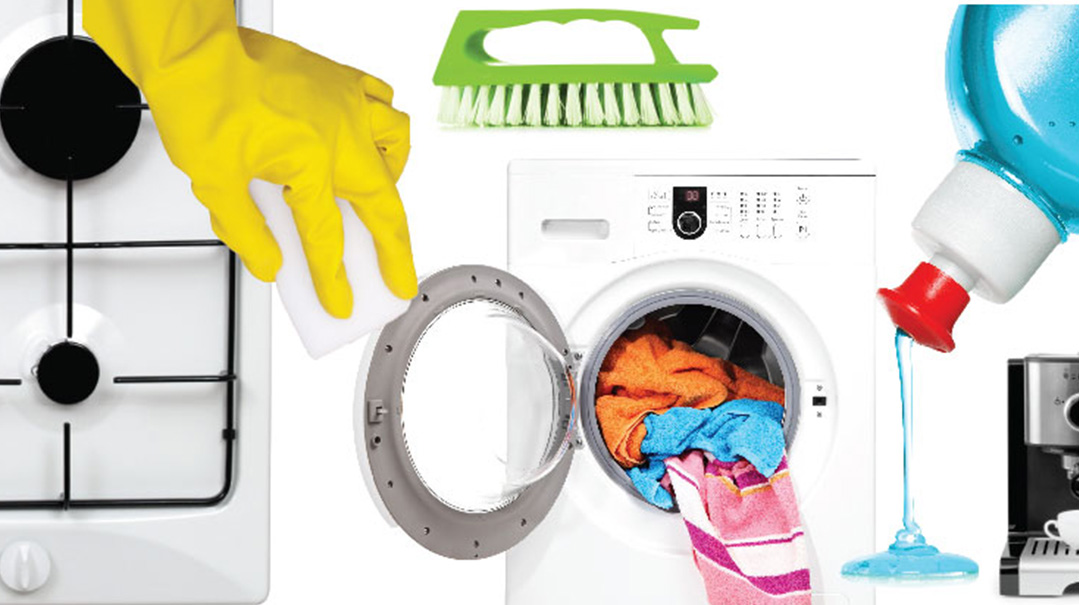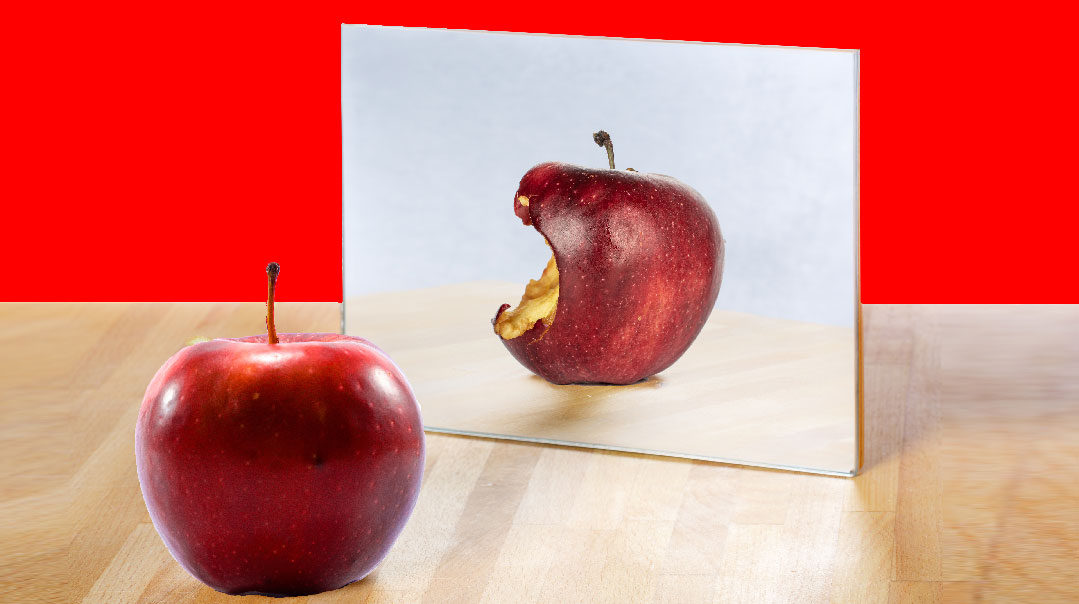10 Cleaning Conundrums Solved

Even experienced balabustas might feel flummoxed by a crusty hot water urn or an off-smelling washing machine

Ready to tackle the tough spots?
Get your cleaning gloves on and let’s go.
Oven Grates
The traditional way to clean oven grates — spray strong chemicals liberally and let them sit for a long time — doesn’t do much to remove baked-on grease. And if you don’t want to destroy the shiny chrome finish of your oven grates in the self-clean cycle, here’s my tried-and-true method.
Lay a towel in a bathtub to prevent scratches, and place the grates on top. (Be sure to mark the milchig or fleishig ones with a twist tie or the like so you can tell them apart later.) Fill the bath with hot water and add a generous amount of strong dishwashing soap. Let the grates soak for at least an hour or more.
For the next step, you can remove the grates from the tub if it’s more comfortable, and continue in a large sink or on a towel on the kitchen counter. Wipe each line of the grate with either steel wool or half a piece of magic sponge. The grease should come right off, leaving shiny chrome. If you’re continuing in the bathtub, make sure to use steel wool that doesn’t shed; otherwise, the small pieces could cause rust damage to the bathtub and towel.
For stubborn grime, apply a little more elbow grease. If all else fails, repeat the soak.
Iron
If you thought you never had to clean an iron, think again. A scorched iron can ruin clothing. To get it back in working order, first heat it slightly, then wipe down with a white miracle sponge. Repeat this process a few times.
If the stainless steel plate is still dirty, dip a rag in a vinegar-water mixture and dab with a bit of baking soda, then scrub the dirty spots. (Never use steel wool or abrasive cleaners — they can damage the special coating on the bottom.) Clean off residue with a clean rag and another round of miracle sponge if necessary.
Remember, it’s easiest to clean the iron when it is warm. But remember to protect your hands with heatproof gloves.
The steam vents can also get clogged. If you’re lucky, your iron has an auto-clean button. If not, heat the iron for a few minutes on the highest setting. Then hold the iron over the sink, turn to the highest steam pressure, and push the steam button repeatedly. Twist the iron in both directions to make sure you hit every vent.
Stainless-Steel Appliances
Stainless steel is easily scratched, so use only soft materials — even paper towels may be too coarse. For a quick clean and shine, I like Weiman Stainless Steel Wipes — simply wipe in the direction of the grain. (Dry with a soft cloth if still wet after wiping.) If the appliance is very dirty, clean first with a magic sponge, then shine with a wipe.
If you notice any rust, make a paste of baking soda and water and rub in with a soft cloth or sponge in the direction of the grain. The paste will also work on a greasy oven keypad, gently applied with a soft cloth. You might want to try my mother’s trick — she covers the keypad with saran wrap, which she replaces as needed.
Attention messy cooks: Even you can maintain a clean stainless stovetop. Resist the urge to use steel wool, scrubbies, or coarse materials. Instead, remove larger clumps of dirt and grease with a soft wet cloth. Use warm water to loosen very stubborn grease. For a final shine, use those wipes again!
Stainless-steel sinks — even faucets — can be freshened up with the wipes too. (The wipes are also perfect for stainless steel cabinet pulls.) For a more thorough sink cleaning, try a magic sponge or baking soda with water. And remember to pour a bit of bleach down the drain every few months to keep it smelling clean and fresh.
For hard water stains on the faucet arm, wrap with a soft cloth soaked in vinegar for at least an hour. The stains should wipe off easily; otherwise, repeat.
Front-Loading Washing Machines
When my neighbor complained of a terrible odor from her washing machine, I knew just what to do. I lent her my expensive bottle of Glisten Washer Magic which saved her laundry. Then I learned about a cheaper solution: running the machine’s sanitary or cleaning cycle to keep mold from growing around the rubber seal. (If you don’t have a special cycle, use the hottest regular cycle.)
You can also spray the inside of the rubber seal with bleach and wipe. (Of course, keep the bleach away from your clothing or it becomes a very expensive option.) Already got mold? Reach in the holes and around the inside of the rubber seal with a Q-tip dipped in a bleach-water solution. (Fold it forward to reach every spot.) Afterward, run the machine empty with two cups of vinegar.
For regular maintenance, remove laundry as soon as it’s finished. (Riiiight… or at least open the door to let the air in.) Never completely close the machine if the rubber seal is still wet; hang a small washcloth over the door to keep it open. Each week, wipe out the detergent drawer and the inside and outside of the door.
A similar practice can keep your dishwasher fresh and clean too. Run an empty cycle on the hottest setting with a dishwasher-safe container or cup of vinegar on the top rack. Leave the door slightly open when not in use to avoid mold or a bad odor.
Descaling Appliances
Want your urn or kettle to last? The answer is descaling: removing those chemical deposits from the water left on the walls of your urn. It’s generally recommended to descale once a month.
Here’s what you do: Fill the kettle halfway with water and boil, then add two table spoons of citric acid (aka lemon salt, often found in the spice section of the grocery). Return to a boil. Pour the water through the spout of the kettle to clean it. For your urn, pump some of the boiled water through the spout and then pour out the rest of the water. Refill with clean water, boil again, and pump out again through the spout, then dispose of the water. Follow every descaling with a clean boil, or you’ll end up thinking the milk in your coffee is sour.
For coffee makers and Keurigs, vinegar is usually better for descaling. Combine equal parts vinegar and water in the water chamber. Start a brew cycle and then pause it midway so it can sit for an hour. Brew completely and dispense the water repeatedly into a large mug until it’s all out. Follow with a clean water cycle.
Floors
Rubber brooms, an Israeli innovation, are all the rage. Slim and easy to use, this broom gathers up the most dust and can easily reach into corners. If sweeping a larger space, it is best to gather smaller piles of dust and dispose so that the dust doesn’t blow in the air and settle on the floor again.
When it comes to cleaning dirt, Bona Hardwood Floor Cleaner is best for hardwood floors with a dull or matte finish. Follow the instructions, and your floor will look infinitely better than it does with any other detergent. No Bona? No problem — use a mixture of vinegar and water and squeeze out as much liquid from the rag as possible.
Vinegar and water also work well for shiny ceramic floors. You won’t find any streaks afterward.
For glossy or semi-glossy hardwood floors, a wax polish can be applied every half a year. Try Mop & Glo or Orange Glo and follow the instructions carefully. Use sparingly — too much will cause an unwanted wax buildup that can only be removed with an ammonia solution.
Walls, Cabinets, and Drawers
A magic sponge is your friend for walls, doors, cabinets, drawers, and any type of woodworking or panels with washable paint. They can look new again, saving you money on a new paint job. Just a quick money-saving hint — be sparing with your water. If you wet the entire sponge and squeeze it out, you’ll dilute the strength of the cleaning chemicals and lose a lot of the benefit of the sponge. Dip only a corner into water, and then use it directly on the surface.
If you’re worried you’ll discolor the wall or whatever you’re cleaning, test first in a discrete spot. Be careful to rub gently too. After cleaning with the sponge, wipe with a clean, wet rag to prevent detergent streaks. Dry immediately.
Deck or Siding
Does your wooden deck, concrete, or vinyl siding need professional help? Try a quick shortcut first. Most hardware stores sell a power-washer pressure nozzle that can be attached to a regular garden hose. Some even have a compartment for detergent to ensure a deep clean. For mold stains, you can add bleach to the power washer or scrub with a soft brush dipped into bleach between power washing.
You can also rent a power washer from hardware stores.
Wood Furniture
Take a breather — thankfully, most wood furniture doesn’t need a deep clean. A simple wipe with a dry microfiber cloth removes dust, and then a swipe with Weiman Wood Furniture Wipes restores the polish. Make sure to wipe in the direction of the grain, and dry if necessary — who wants spots?!
For small scratches, wood touch-up markers come in all of the popular shades of wood stains, and they’re kinda fun to use too. Larger areas may be able to be restored with Old English Scratch Cover which works for all types of wood finishes. Choose the color that most closely matches your wood stain. Pour a little bit onto a soft cloth and rub into scratch or spot. Apply repeatedly and buff until the scratch is nearly invisible. That’s as good as it gets!
Filters
Filters catch dust, dirt, bacteria — all that grimy stuff you don’t want in your home. Cleaning them out improves the efficiency of the machine. Check if your refrigerator, dishwasher or over-the-range hood has a vent. Most vents can be cleaned but some need to be replaced with a manufacturer-approved replacement.
It’s easy to remove the filters in window, wall, and split-unit air conditioners. Hold each filter over a bathtub and spray down with the strongest setting of a handheld shower head. (Extra-large filters can be cleaned outside with the garden hose.) Let drip-dry completely before reinserting. If a vent is particularly greasy, use warm soap and a brush to remove stuck-on lint. Filters in a central air conditioner may either be washed or replaced.
To improve air circulation, you’ll want to clean the air conditioning ducts or vents throughout the house. Remove vent covers. (Tip: Secure the screws to each vent cover with tape or place in a cup so you don’t lose them.) Start with a vacuum cleaner to get all the loose dust right away, without blowing it away. Reach into the cavity as far as you can and wipe away remaining dust with a dry rag — you don’t want to use water to clean dust. You can try using a brush to loosen any lint, then vacuum again.
The vent covers should also be wiped with a clean dry rag. If you see greasy lint, wash lightly with warm water and soap. Don’t rub too hard, or you might remove the paint. Check the back of the vents too; if there’s still a lot of greasy dust, dab alcohol on a rag and wipe. Make sure the covers are completely dry before screwing them back into place.
As for your vacuum, it might also have a filter that needs to be cleaned or changed. Many newer vacuum cleaners come with a small foam filter that has to be cleaned regularly. Check the manual for its location and remove it. Hold under a stream of water and squeeze until the foam returns to its original white or yellow color. If it is very dirty, use some soap and make sure to rinse it well. Again, the filter must be completely dry before replacing it.
Your dryer is another filter spot in your home. Get in the habit of removing the lint every cycle. It will keep your dryer running efficiently. You might still need a deeper lint cleaning every few months: Use a vacuum to clean the lint trap and to reach deeper into its cavity. Soak the lint trap in warm soapy water, and use a brush to remove all lint. How do you know it’s clean? Water should easily flow through the mesh filter. Of course, make sure it is completely dry before replacing it.
If you find your clothing is still damp after a full cycle, get the dryer vent professionally cleaned to prevent a fire.
(Originally featured in Family First, Issue 545)
Oops! We could not locate your form.






